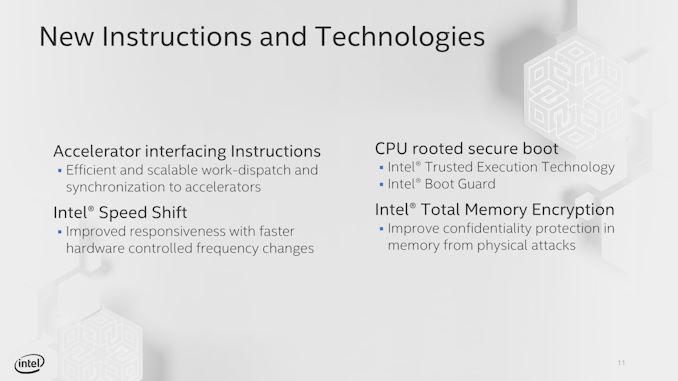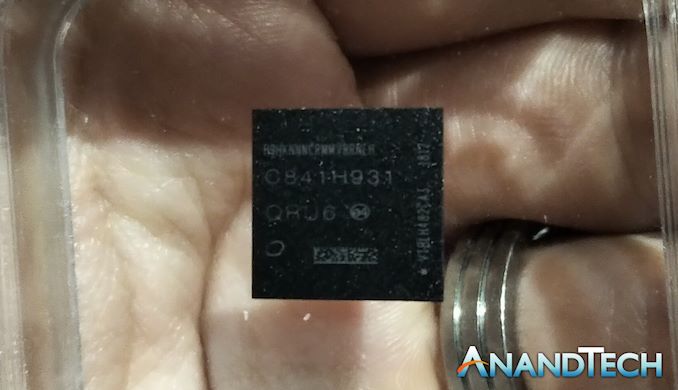Intel's new Atom Microarchitecture: The Tremont Core in Lakefield
by Dr. Ian Cutress on October 24, 2019 1:30 PM ESTBeyond the Core
Nominally today’s disclosure is more about the Tremont microarchitecture than any SoC it might appear in, like Lakefield or Snow Ridge. To that end, Intel wasn’t talking about GPU support (Lakefield will have Gen11 graphics), but Intel did discuss that Tremont would be the first Atom design to fully support Intel’s Speed Shift / ACPI hardware flags, allowing for faster ramp-up and ramp-down of high-frequency operation.
Intel also stated that Tremont supports Total Memory Encryption to prevent physical attacks, Rooted Secure Boot and Boot Guard, and specific accelerator interfacing instructions. With respect to Spectre, Meltdown, and L1TF, Intel stated that Tremont will have the same protections as Cascade Lake.
We also asked Intel about module-level voltage and power control. We were told that within a quad-core module with four Tremont cores, all the cores share the same frequency plane, but each core can enter separate c-states to reduce power consumption when not in use.
Final Thoughts and Slide Deck
In the past, at least from my perspective, dealing with Atom platforms has been amusing. Atom devices typically work great for hyper-focused and optimized software that can take advantage of a latency-insensitive workload, such as networking equipment or a NAS, but for any general purpose use I find them incredibly slow. Perhaps I’m just too used to the big cores on the devices I use – but with Intel saying that Atom is being refocused on performance, it will be interesting to see how Tremont devices and other Core devices will overlap. This graph from Intel is very striking, and if you squint, it looks a lot like some of the smartphone power/performance graphs we’ve produced in the past.
With Intel moving Core down in power to the 1.5W level, again it will be interesting to see how Tremont can play in that 2mW to 2W range that Atom has traditionally played in. The last generation Goldmont Plus devices were going beyond that, and in this power range we also have smartphone cores coming into play. After showing the slide deck to Andrei, we were discussing how a Tremont might stack up against an Arm Cortex A76, or a Kryo core. When we can get our hands on Tremont, we’ll see how they compare. When it comes to the products that Tremont is aiming for however, it still has that x86 advantage.
We did ask a few questions from Intel that we didn’t get answers to, such as die size and target frequencies. The other question to discuss is Intel’s current high-demand issues putting pressure on its manufacturing technologies. Tremont is still a low cost, low powered core, so logic may dictate that it will be a while before we see consumer chips enter the market. Ultimately Intel’s high-demand issues are around 14nm, and so far we’ve only seen Tremont discussed on Intel’s 10+ process with Lakefield and Snow Ridge. What we know about Intel’s 10nm/10+ capacity isn’t a lot, but reports vary from yields being ‘on track’ to ‘working with key OEM partners only’. Intel’s driver for 10+ right now is Ice Lake, which is coming to some premium notebook designs this year, and Lakefield has been announced for the Surface Neo. It is not known what the expected volume for the Neo will be, but it is unlikely to be large. Whether or not Tremont will see the light of day in traditional Atom Celeron and Pentium processors is another question entirely – the Goldmont Atom families have suffered while Intel’s 14nm efforts are more focused on enterprise hardware that can be sold for a much higher $$ per square millimeter. Beyond Lakefield, we might not actually see Tremont in any other consumer chip before the next generation Atom if Intel cannot get its issues sorted.
As and when we get a Lakefield device, we will put it through our tests. Stay tuned.













101 Comments
View All Comments
Namisecond - Friday, November 1, 2019 - link
Which will be far more important for devices that run Windows.petr.koc - Friday, October 25, 2019 - link
"the enterprise side has been dealing with a clock degradation issue that ultimately leaves Atom systems built on C2000 processors unable to boot,"This is unfortunately not precise as all Atom Bay Trail processors (desktop, mobile, server) including 14nm successors manufactured up to approximately 2018 are affected with LPC circuitry degradation issue that will kill them in the end:
https://en.wikipedia.org/wiki/Silvermont#Erratum
https://en.wikipedia.org/wiki/Goldmont#Erratum
29a - Friday, October 25, 2019 - link
Ugh, I just look at your links and I have a NAS box with a J1900. I wonder what can be done to replace it?MASSAMKULABOX - Thursday, October 31, 2019 - link
Yeah, I'm amazed this didnt byte Intel in the Ass much harder, AFAIK synology and cisco were both victims and I'm sure many others. So, start by making well-tested, reliable products.. and no harm in boosting up the GFX side of things (x2 X3?). Give us desktop systems @10w and lowerBigos - Friday, October 25, 2019 - link
> (We therefore assume that a 3.0 MB L2 will be 15-way.)That is very unlikely. 3.0MB (which is 3 * 1024 * 1024) is not divisible by 15. I'm sure the 3MB L2$ will be 12-way associative.
1.5MB = 12 * 128kB
3.0MB = 12 * 256kB
4.5MB = 18 * 256kB
AntonErtl - Friday, October 25, 2019 - link
It's clear that they drop products with low-$/area when they do not have enough capacity, but AFAIK that's not the case at the moment for 10nm; on the contrary, they have 10nm capacity and not much demand for Ice Lake (because they cannot get the clock rates and efficiency competetive with the 14nm Skylake derivatives). So building Tremont-based successors for Gemini Lake (where performance is not as critical) would be a way for them to get more revenue out of their 10nm production line(s?); of course they have to design that first, and they may have failed to do so, expecting Ice Lake production to be in full swing by now.Concerning sucking performance, here are some numbers for our LaTeX benchmark http://www.complang.tuwien.ac.at/franz/latex-bench...
2.368 Intel Atom 330, 1.6GHz, 512K L2 Zotac ION A
1.052 Celeron J1900 (Silvermont) 2416MHz (Shuttle XS35V4)
0.712 Celeron J3455 (Goldmont) 2300MHz, ASRock J3455-ITX
0.540 Celeron J4105 (Goldmont+) 2500MHz
0.200 Core i7-6700K (Skylake), 4200MHz
Skylake has about a factor 1.6 better IPC than Goldmont+, and allows higher clock rates (at higher power consumption), resulting in significantly better overall performance, but whether that makes the Goldmont+ suck depends on the application.
29a - Friday, October 25, 2019 - link
Decoding video, that's what the other two Atoms I've owned sucked at.PeachNCream - Friday, October 25, 2019 - link
You keep thrashing at that, but other people that have dissimilar experiences have supported claims that run contrary to your statements. What model Atoms and under what conditions haev you had this problem? This isn't an issue for anyone else and, frankly, watching video isn't the only thing a computer does so that complaint may have no impact on the wider range of use cases beyond watching YouTube and Netflix.Jorgp2 - Friday, October 25, 2019 - link
He probably has an in order atom.Pretty much all out of order atoms have hardware decoding acceleration
GreenReaper - Saturday, October 26, 2019 - link
Or, he's trying to decode a video that isn't supported by the hardware. Like 10-bit anything until very recent. In fairness my Bobcat cores struggle with 60FPS anything, and plain Full HD MP4 decode also bogs down if you add anything but the most minimal of shader filters. But they're from ~2011.